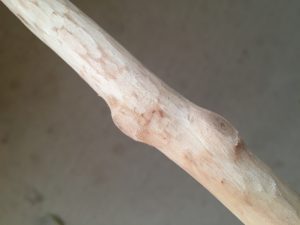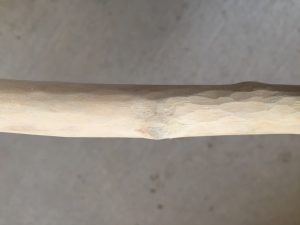Cleaning
Since willow wood has many layers of different colors it is pretty easy to see how far down I have cut/shaved but on the other hand it is difficult to keep the exterior consistent depending on the tool I used. In the image below you can see where I used a pocket knife (left side) which shows exactly where the blade removed the wood but the Dremel (right side) shaved it off leaving a more blended texture in appearance.

In either case these variances will mostly disappear once I begin the sanding process.

In the image above you will see where I sanded (left side) compared to the side that has not been sanded. Most of the beveled areas disappear but if they are still visible it is no big deal to me. Once the color is applied it is hard to see them unless you look really closely. While sanding I always wear a dust mask to help protect myself from inhaling any of the sawdust.
I start with 300-400 grit sandpaper to sand the entire stick. I dust off the sandpaper occasionally because if I keep sanding the dust will just pile up and I’ll be smearing it around. After I feel that the whole stick is sanded it feels really smooth to the touch but then I wipe it down with a damp paper towel to remove the dust that is on the surface. During sanding the dust will pile up on the surface which is what gives it the smooth texture but once the water removes it the texture becomes noticeably rougher.
After the stick dries I use 1000 grit sandpaper and repeat the process. The same is done with 1500 and 2000 grit paper. By the end I will have sanded in four stages and most of the surface texture will be smooth.
The final step in the cleaning phase is literally cleaning. I fill a cup with household bleach and using a paper towel I dab the bleach on the stick.
Note: I always wear eye protection (like goggles), a face mask, and gloves when handling bleach. It is a hazardous chemical and I don’t take risks when handling it. I also perform this step outdoors or in a well ventilated room.
The reason for this is to remove any mold or other harmful substance from the wood that may have been present. Mold that grows on the exterior of the wood appears in little black spots that eventually grow larger and may change color. You may be wondering why I do this at this part of the process. Any harmful substance that was on the bark would have been removed at the same time the bark was peeled away and even if I used bleach at this point, tree bark is naturally resistant to external contamination so the bleach would not have penetrated to the interior of the wood. There may be some sort of bacteria or other problem with the wood on the inside that may not be visible once the bark is removed so the bleach helps get rid of anything that might be present. The interior layers of the wood are not as resistant as the bark so the bleach has an easier time soaking in.
I use a lot of bleach to make sure the entire stick is soaked through and then leave it to dry for at least 24 hours. If it still feels damp after that time, I leave it for another 24 hours. Again, I don’t take risks with bleach so if the wood is not completely dry I wait until it is done.
